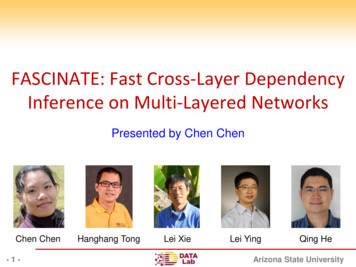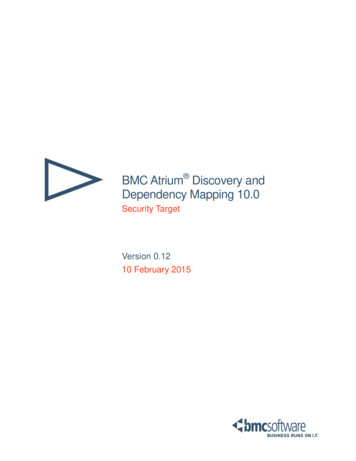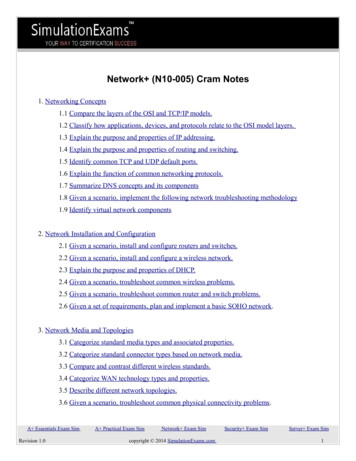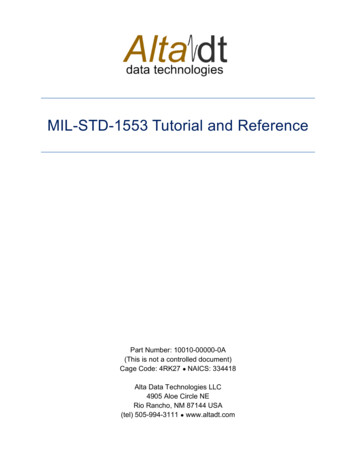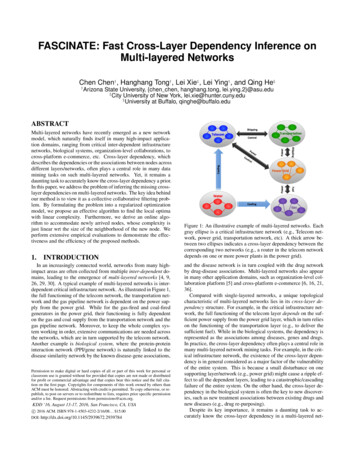
Transcription
FASCINATE: Fast Cross-Layer Dependency Inference onMulti-layered NetworksChen Chen† , Hanghang Tong† , Lei Xie‡ , Lei Ying† , and Qing He§†Arizona State University, {chen chen, hanghang.tong, lei.ying.2}@asu.edu‡City University of New York, lei.xie@hunter.cuny.edu§University at Buffalo, qinghe@buffalo.eduABSTRACTMulti-layered networks have recently emerged as a new networkmodel, which naturally finds itself in many high-impact application domains, ranging from critical inter-dependent infrastructurenetworks, biological systems, organization-level collaborations, tocross-platform e-commerce, etc. Cross-layer dependency, whichdescribes the dependencies or the associations between nodes acrossdifferent layers/networks, often plays a central role in many datamining tasks on such multi-layered networks. Yet, it remains adaunting task to accurately know the cross-layer dependency a prior.In this paper, we address the problem of inferring the missing crosslayer dependencies on multi-layered networks. The key idea behindour method is to view it as a collective collaborative filtering problem. By formulating the problem into a regularized optimizationmodel, we propose an effective algorithm to find the local optimawith linear complexity. Furthermore, we derive an online algorithm to accommodate newly arrived nodes, whose complexity isjust linear wrt the size of the neighborhood of the new node. Weperform extensive empirical evaluations to demonstrate the effectiveness and the efficiency of the proposed methods.1.INTRODUCTIONIn an increasingly connected world, networks from many highimpact areas are often collected from multiple inter-dependent domains, leading to the emergence of multi-layered networks [4, 9,26, 29, 30]. A typical example of multi-layered networks is interdependent critical infrastructure network. As illustrated in Figure 1,the full functioning of the telecom network, the transportation network and the gas pipeline network is dependent on the power supply from the power grid. While for the gas-fired and coal-firedgenerators in the power grid, their functioning is fully dependenton the gas and coal supply from the transportation network and thegas pipeline network. Moreover, to keep the whole complex system working in order, extensive communications are needed acrossthe networks, which are in turn supported by the telecom network.Another example is biological system, where the protein-proteininteraction network (PPI/gene network) is naturally linked to thedisease similarity network by the known disease-gene associations,Permission to make digital or hard copies of all or part of this work for personal orclassroom use is granted without fee provided that copies are not made or distributedfor profit or commercial advantage and that copies bear this notice and the full citation on the first page. Copyrights for components of this work owned by others thanACM must be honored. Abstracting with credit is permitted. To copy otherwise, or republish, to post on servers or to redistribute to lists, requires prior specific permissionand/or a fee. Request permissions from permissions@acm.org.KDD ’16, August 13-17, 2016, San Francisco, CA, USAc 2016 ACM. ISBN 978-1-4503-4232-2/16/08. . . 15.00 DOI: http://dx.doi.org/10.1145/2939672.2939784Figure 1: An illustrative example of multi-layered networks. Eachgray ellipse is a critical infrastructure network (e.g., Telecom network, power grid, transportation network, etc). A thick arrow between two ellipses indicates a cross-layer dependency between thecorresponding two networks (e.g., a router in the telecom networkdepends on one or more power plants in the power grid).and the disease network is in turn coupled with the drug networkby drug-disease associations. Multi-layered networks also appearin many other application domains, such as organization-level collaboration platform [5] and cross-platform e-commerce [6, 16, 21,36].Compared with single-layered networks, a unique topologicalcharacteristic of multi-layered networks lies in its cross-layer dependency structure. For example, in the critical infrastructure network, the full functioning of the telecom layer depends on the sufficient power supply from the power grid layer, which in turn relieson the functioning of the transportation layer (e.g., to deliver thesufficient fuel). While in the biological systems, the dependency isrepresented as the associations among diseases, genes and drugs.In practice, the cross-layer dependency often plays a central role inmany multi-layered network mining tasks. For example, in the critical infrastructure network, the existence of the cross-layer dependency is in general considered as a major factor of the vulnerabilityof the entire system. This is because a small disturbance on onesupporting layer/network (e.g., power grid) might cause a ripple effect to all the dependent layers, leading to a catastrophic/cascadingfailure of the entire system. On the other hand, the cross-layer dependency in the biological system is often the key to new discoveries, such as new treatment associations between existing drugs andnew diseases (e.g., drug re-purposing).Despite its key importance, it remains a daunting task to accurately know the cross-layer dependency in a multi-layered net-
work, due to a number of reasons, ranging from noise, incompletedata sources, limited accessibility to network dynamics. For example, an extreme weather event might significantly disrupt thepower grid, the transportation network and the cross-layer dependencies in between at the epicenter. Yet, due to limited accessibilityto the damage area during or soon after the disruption, the crosslayer dependency structure might only have a probabilistic and/orcoarse-grained description. On the other hand, for a newly identified chemical in the biological system, its cross-layer dependencieswrt proteins and/or the diseases might be completely unknown dueto clinical limitations.(i.e., the zero-start problem).In this paper, we aim to tackle the above challenges and developeffective and efficient methods to infer cross-layer dependency onmulti-layered networks. The main contributions of the paper canbe summarized as Problem Formulations. We formally formulate the crosslayer dependency inference problem as a regularized optimization problem. The key idea of our formulation is to collectively leverage the within-layer topology as well as theobserved cross-layer dependency to infer a latent, low-rankrepresentation for each layer, based on which the missingcross-layer dependencies can be inferred. Algorithms and Analysis. We propose an effective algorithm(FASCINATE) for cross-layer dependency inference on multilayered networks, and analyze its optimality, convergenceand complexity. We further present its variants and generalizations, including an online algorithm to address the zerostart problem. Evaluations. We perform extensive experiments on real datasets to validate the effectiveness, efficiency and scalability ofthe proposed algorithms. Specially, our experimental evaluations show that the proposed algorithms outperform theirbest competitors by 8.2%-41.9% in terms of inference accuracy while enjoying linear complexity. Specifically, the proposed FASCINATE -ZERO algorithm can achieve up to 107 speedup with barely no compromise on accuracy.The rest of the paper is organized as follows. Section 2 gives theformal definitions of the cross-layer dependency inference problems. Section 3 proposes FASCINATE algorithm with its analysis.Section 4 introduces the zero-start algorithm FASCINATE -ZERO.Section 5 presents the experiment results. Section 6 reviews therelated works. Section 7 summarizes the paper.2.PROBLEM DEFINITIONIn this section, we give the formal definitions of the cross-layerdependency inference problems. The main symbols used throughout the paper are listed in Table 1. Following the convention, weuse bold upper-case for matrices (e.g., A), bold lower-case for vectors (e.g., a) and calligraphic for sets (e.g., A). A denotes thetranspose of matrix A. We use the ˆ sign to denote the notationsˆ Â1 ), andafter a new node is accommodated to the system (e.g., J,the ones without the ˆ sign as the notations before the new nodearrives.While several multi-layered network models exist in the literature (See Section 6 for a review), we will focus on a recent modelproposed in [5], due to its flexibility to model more complicatedcross-layer dependency structure. We refer the readers to [5] forits full details. For the purpose of this paper, we mainly need thefollowing notations to describe a multi-layered network with g layers. First, we need a g g layer-layer dependency matrix G, whereTable 1: Main Symbols.SymbolA, Ba, bA, BA(i, j)A(i, :)A(:, j)A ÂGADWi,jFimi , n imi,jgrtξDefinition and Descriptionthe adjacency matrices (bold upper case)column vectors (bold lower case)sets (calligraphic)the element at ith row j th columnin matrix Athe ith row of matrix Athe j th column of matrix Atranspose of matrix Athe adjacency matrix of A with the newly added nodethe layer-layer dependency matrixwithin-layer connectivity matrices of the networkA {A1 , . . . , Ag }cross-layer dependency matricesD {Di,j i, j 1, ., g}weight matrix for Di,jlow-rank representation for layer-i (i 1, ., g)number of edges and nodes in graph Ainumber of dependencies in Di,jtotal number of layersthe rank for {Fi }i 1,.,gthe maximal iteration numberthe threshold to determine the iterationG(i, j) 1 if layer-j depends on layer-i, and G(i, j) 0 otherwise. Second, we need a set of g within-layer connectivity matrices: A {A1 , ., Ag } to describe the connectivities/similaritiesbetween nodes within the same layer. Third, we need a set of crosslayer dependency matrices D {Di,j i, j 1, ., g}, whereDi,j describes the dependencies between the nodes from layer-iand the nodes from layer-j if these two layers are directly dependent(i.e., G(i, j) 1). When there is no direct dependencies betweenthe two layers (i.e., G(i, j) 0), the corresponding dependencymatrix Di,j is absent. Taking the multi-layered network in Figure 2 for an example, the abstract layer-layer dependency networkG of this biological system can be viewed as a line graph. Thefour within-layer similarity matrices in A are the chemical network(A1 ), the drug network (A2 ), the disease network (A3 ) and theprotein-protein interaction (PPI) network (A4 ). Across those layers, we have three non-empty dependency matrices, including thechemical-drug dependency matrix (D1,2 ), the drug-disease interaction matrix (D2,3 ) and the disease-protein dependency matrix(D3,4 ).As mentioned earlier, it is often very hard to accurately know thecross-layer dependency matrices {Di,j i, j 1, ., g}. In otherwords, such observed dependency matrices are often incompleteand noisy. Inferring the missing cross-layer dependencies is an essential prerequisite for many multi-layered network mining tasks.On the other hand, real-world networks are evolving over time.Probing the cross-layer dependencies is often a time-consumingprocess in large complex networks. Thus, a newly added nodecould have no observed cross-layer dependencies for a fairly longperiod of time since its arrival. Therefore, inferring the dependencies of such kind of zero-start nodes is an important problem thatneeds to be solved efficiently. Formally, we define the cross-layerdependency inference problem (C ODE) and its corresponding zerostart variant (C ODE -ZERO) as follows.P ROBLEM 1. (C ODE) Cross-Layer Dependency InferenceGiven: a multi-layered network with (1) layer-layer dependency matrix G; (2) within-layer connectivity matrices A {A1 , ., Ag };and (3) observed cross-layer dependency matrices D {Di,j i, j 1, ., g};
Figure 2: A simplified 4-layered network for biological systems.Output: the true cross-layer dependency matrices {D̃i,j i, j 1, ., g} .P ROBLEM 2. (C ODE -ZERO) Cross-Layer Dependency Inference for zero-start NodesGiven: (1) a multi-layered network {G, A, D}; (2) a newly addednode p in the lth layer; (3) a 1 nl vector s that records the connections between p and the existing nl nodes in layer l;Output: the true dependencies between node p and nodes in dependent layers of layer-l, i.e., D̃l,j (p, :) (j 1, ., g, G(l, j) 1).3.FASCINATE FOR PROBLEM 13.2The key idea behind our formulation is to treat Problem 1 asa collective collaborative filtering problem. To be specific, if weview (1) nodes from a given layer (e.g., power plants) as objectsfrom a given domain (e.g., users/items), (2) the within-layer connectivity (e.g., communication networks) as an object-object similarity measure, and (3) the cross-layer dependency (e.g., dependencies between computers in the communication layer and powerplants in power grid layer) as the ‘ratings’ from objects of one domain to those of another domain; then inferring the missing crosslayer dependencies can be viewed as a task of inferring the missing ratings between the objects (e.g., users, items) across differentdomains. Having this analogy in mind, we propose to formulateProblem 1 as the following regularized optimization problem J Wi,j (Di,j Fi Fj ) 2F (1)mini,j: G(i,j) 1 The derivative of Ji wrt Fi is Ji 2( Fi α i 1tr(Fi (Ti Ai )Fi ) β C2: Node Homophily g i 1[ (Wi,j Wi,j Di,j )Fj(3)j: G(i,j) 1A fixed-point solution of Eq. (3) with non-negativity constrainton Fi leads to the following multiplicative updating rule for Fi X(u, v)(4)Fi (u, v) Fi (u, v)Y(u, v)whereX (Wi,j Wi,j Di,j )Fj αAi Fi(5)j: G(i,j) 1 (Wi,j Wi,j (Fi Fj ))Fj αTi Fi βFij: G(i,j) 1C1: Matching Observed Cross-Layer Dependenciesg (Wi,j Wi,j (Fi Fj ))Fj ] αTi Fi αAi Fi βFi )Y j: G(i,j) 1 αtr(Fi (Ti Ai )Fi ) β Fi 2FFASCINATE: Optimization FormulationFi 0(i 1,.,g)FASCINATE: Optimization AlgorithmThe optimization problem defined in Eq. (1) is non-convex. Thus,we seek to find a local optima by the block coordinate descentmethod, where each Fi naturally forms a ‘block’. To be specific,if we fix all other Fj (j 1, . . . , g, j i) and ignore the constantterms, Eq. (1) can be simplified as (2) Wi,j (Di,j Fi Fj ) 2FJi Fi 0In this section, we present our proposed solution for Problem 1(C ODE). We start with the proposed optimization formulation, andthen present our algorithm (FASCINATE), followed by some effectiveness and efficiency analysis.3.1ferent weights to different entries in the corresponding cross-layerdependency matrix Di,j ; and Fi is the low-rank representation forlayer i. For now, we set the weight matrices as follows: Wi,j (u, v) 1 if Di,j (u, v) is observed, and Wi,j (u, v) [0, 1] if Di,j (u, v) 0 (i.e., unobserved). To simplify the computation, we set theweights of all unobserved entries to a global value w. We will discuss alternative choices for the weight matrices in Section 3.3.In this formulation (Eq. (1)), we can think of Fi as the low-rankrepresentations/features of the nodes in layer i in some latent space,which is shared among different layers. The cross-layer dependencies between the nodes from two dependent layers can be viewedas the inner product of their latent features. Therefore, the intuitionof the first term (i.e. C1) is that we want to match all the crosslayer dependencies, calibrated by the weight matrix Wi,j . Thesecond term (i.e., C2) is used to achieve node homophily, whichsays that for a pair of nodes u and v from the same layer (saylayer-i), their low-rank representations should be similar (i.e., small Fi (u, :) Fi (v, :) 2 ) if the within-layer connectivity betweenthese two nodes is strong (i.e., large Ai (u, v)). The third term (i.e.C3) is to regularize the norm of the low-rank matrices {Fi }i 1,.,gto prevent over-fitting.Once we solve Eq. (1), for a given node u from layer-i and anode v from layer-j, the cross-layer dependency between them canbe estimated as D̃i,j (u, v) Fi (u, :)Fj (v, :) . Fi 2F C3: Regularizationwhere Ti is the diagonal degree matrix of Ai with Ti (u, u) niv 1 Ai (u, v); Wi,j is an ni nj weight matrix to assign dif-Recall that we set Wi,j (u, v) 1 when Di,j (u, v) 0, andWi,j (u, v) w when Di,j (u, v) 0. Here, we define IOi,jas an indicator matrix for the observed entries in Di,j , that is,OIOi,j (u, v) 1 if Di,j (u, v) 0, and Ii,j (u, v) 0 if Di,j (u, v) 0. Then, the estimated dependencies over the observed data can berepresented as R̃i,j IOi,j (Fi Fj ). With these notations, we can
further simplify the update rule in Eq. (5) as follows Di,j Fj αAi FiX By the KKT complementary slackness condition, we have(6) (Wi,j Wi,j (Fi Fj ))Fj αTi Fi βFij: G(i,j) 1j: G(i,j) 1Y [((1 w2 )R̃i,j w2 Fi Fj )Fj αTi Fi βFi (j: G(i,j) 1(7)The proposed FASCINATE algorithm is summarized in Alg. 1.First, it randomly initializes the low-rank matrices for each layer(line 1 - line 3). Then, it begins the iterative update procedure.In each iteration (line 4 - line 10), the algorithm alternatively updates {Fi }i 1,.,g one by one. We use two criteria to terminatethe iteration: (1) either the Frobenius norm between two successiveiterations for all {Fi }i 1,.,g is less than a threshold ξ, or (2) themaximum iteration number t is reached.Algorithm 1 The FASCINATE AlgorithmInput: (1) a multi-layered network with (a) layer-layer dependency matrix G, (b) within-layer connectivity matrices A {A1 , ., Ag }, and (c) observed cross-layer node dependencymatrices D {Di,j i, j 1, ., g}; (2) the rank size r; (3)weight w; (4) regularized parameters α and β;Output: low-rank representations for each layer {Fi }i 1,.,g1: for i 1 to g do2:initialized Fi as ni r non-negative random matrix3: end for4: while not converge do5:for i 1 to g do6:compute X as Eq. (6)7:compute Y as Eq. (7)8:update Fi as Eq. (4)9:end for10: end while11: return {Fi }i 1,.,g (10) Y(Wi,j Wi,j Di,j )Fj αAi Fi )](u, v)Fi (u, v) 0j: G(i,j) 1 XTherefore, we can see that the fixed point solution of Eq. (4) satisfies the above equation.The convergence of the proposed FASCINATE algorithm is givenby the following lemma.L EMMA 1. Under the updating rule in Eq. (4), the objectivefunction in Eq. (2) decreases monotonically.P ROOF. Omitted for brevity.According to Theorem 1 and Lemma 1, we conclude that Alg. 1converges to a local minimum solution for Eq. 2 wrt each individualFi .B - Efficiency Analysis.In terms of efficiency, we analyze both the time complexity aswell as the space complexity of the proposed FASCINATE algorithm, which are summarized in Lemma 2 and Lemma 3. We cansee that FASCINATE scales linearly wrt the size of the entire multilayered network.L EMMA 2. The time complexity of Alg. 1 is O([(mi,j r (ni nj )r2 ) mi r)]t).g ( i 1 j: G(i,j) 1Fi , the comP ROOF. In each iteration in Alg. 1 for updating mi,j r mi r)plexity of calculating X by Eq. (6) is O(j: G(i,j) 13.3Proof and AnalysisHere, we analyze the proposed FASCINATE algorithm in termsof its effectiveness as well as its efficiency.A - Effectiveness Analysis.In terms of effectiveness, we show that the proposed FASCINATEalgorithm indeed finds a local optimal solution to Eq. (1). To seethis, we first give the following theorem, which says that the fixedpoint solution of Eq. (4) satisfies the KKT condition.T HEOREM 1. The fixed point solution of Eq. (4) satisfies theKKT condition.P ROOF. The Lagrangian function of Eq. (2) can be written as Wi,j (Di,j Fi Fj ) 2F(8)Li j: G(i,j) 1 αtr(Fi Ti Fi ) αtr(Fi Ai Fi ) β Fi 2F tr(Λ Fi )where Λ is the Lagrange multiplier. Setting the derivative of Li wrtFi to 0, we get [ (Wi,j Wi,j Di,j )Fj(9)2(j: G(i,j) 1 (Wi,j Wi,j (Fi Fj ))Fj ] αTi Fi αAi Fi βFi ) Λdue to the sparsity of Di,j and Ai . The complexity of computingR̃i,j in Y is O(mi,j r). Computing Fi (F j Fj ) requires O((ni nj )r2 ) operations and computing αTi Fi βFi requires2 O(ni r)(mi,j r (ni nj )r )) comoperations. So, it is of O(j: G(i,j) 1 (mi,j r plexity to get Y in line 7. Therefore, it takes O(j: G(i,j) 1(ni nj )r2 ) mi r) to update Fi . Putting all together, the comg plexity of updating all low-rank matrices in each iteration is O(i 1 ((mi,j r (ni nj )r2 ) mi r)). Thus, the overallj: G(i,j) 1complexity of Alg. 1 is O([g ( (mi,j r (ni nj )r2 ) i 1 G(i,j) 1mi r)]t), where t is the maximum number of iterations in the algorithm. L EMMA 3. The space complexity of Alg. 1 is O( gi 1 (ni r mi,j ) .mi ) i,j: G(i,j) 1 P ROOF. ItO( gi 1 n i r) to store all the low-rank matri takesgmi,j ) to store all the withinces, and O( i 1 mi i,j: G(i,j) 1layer connectivity matrices and dependency matrices in the multilayered network.To calculate X for Fi , it costs O(ni r) to com Di,j Fj and αAi Fi . For Y, the space cost of computej: G(i,j) 1puting R̃i,j and Fi (F j Fj ) is O(mi,j ) and O(ni r) respectively.
Therefore, the space complexity of calculating ((1 j: G(i,j) 1w2 )R̃i,j w2 Fi Fj )Fj is O(maxj: G(i,j) 1mi,j ni r). On theother hand, the space required to compute αTi Fi βFi is O(ni r).Putting all together, the space cost of updating all low-rank matrices in each iteration is of O( maxmi,j maxi ni r). Thus,i,j: G(i,j) 1 the overallspace complexity of Alg. 1 is O( gi 1 (ni r mi ) mi,j ).i,j: G(i,j) 1C - Variants.Here, we discuss some variants of the proposed FASCINATE algorithm. First, by setting all the entries in the weight matrix Wi,jto 1, FASCINATE becomes a clustering algorithm (i.e., Fi can beviewed as the cluster membership matrix for nodes in layer-i). Furthermore, if we restrict ourselves to two-layered networks (i.e.,g 2), FASCINATE becomes a dual regularized co-clustering algorithm [20]. Second, by setting w (0, 1), FASCINATE can be usedto address one class collaborative filtering problem, where implicitdependencies extensively exist between nodes from different layers. Specifically, on two-layered networks, FASCINATE is reducedto a weighting-based, dual-regularized one class collaborative filtering algorithm [37]. Third, when the within-layer connectivitymatrices A {A1 , . . . , Ag } are absent, the proposed FASCINATEcan be viewed as a collective matrix factorization method [32].While the proposed FASCINATE includes these existing methodsas its special cases, its major advantage lies in its ability to collectively leverage all the available information (e.g., the within-layerconnectivity, the observed cross-layer dependency) for dependencyinference. As we will demonstrate in the experimental section, sucha methodical strategy leads to a substantial and consistent inferenceperformance boosting. Nevertheless, a largely unanswered question for these methods (including FASCINATE) is how to handlezero-start nodes. That is, when a new node arrives with no observed cross-layer dependencies, how can we effectively and efficiently infer its dependencies without rerunning the algorithm fromscratch. In the next section, we present a sub-linear algorithm tosolve this problem (i.e., Problem 2).4.FASCINATE-ZERO FOR PROBLEM 2A multi-layered network often exhibits high dynamics, e.g., thearrival of new nodes. For example, for a newly identified chemicalin the biological system, we might know how it interacts with someexisting chemicals (i.e., the within-layer connectivity). However,its cross-layer dependencies wrt proteins and/or diseases might becompletely unknown . This section addresses such zero-start problems (i.e., Problem 2). Without loss of generality, we assume thatthe newly added node resides in layer-1, indexed as its (n1 1)thnode. The within-layer connectivity between the newly added nodeand the existing n1 nodes is represented by a 1 n1 row vector s,where s(u) (u 1, ., n1 ) denotes the (within-layer) connectivitybetween the newly added node and the uth existing node in layer-1.We could just rerun our FASCINATE algorithm on the entire multilayered network with the newly added node to get its low-rank representation (i.e., a 1 r row vector f ), based on which its crosslayer dependencies can be estimated. However, the running timeof this strategy is linear wrt the size of the entire multi-layerednetwork. For example, on a three-layered infrastructure networkwhose size is in the order of 14 million, it would take FASCINATE2, 500 seconds to update the low-rank matrices {Fi } for a zerostart node with rank r 200, which might be too costly in onlinesettings. In contrast, our upcoming algorithm is sub-linear, and itonly takes less than 0.001 seconds on the same network withoutjeopardizing the accuracy.There are two key ideas behind our online algorithm. The firstis to view the newly added node as a perturbation to the originalnetwork. In detail, the updated within-layer connectivity matrixÂ1 for layer-1 can be expressed asÂ1 A1ss 0(11)where A1 is the within-layer connectivity matrix for layer-1 beforethe arrival of the new node.Correspondingly, the updated low-rank representation matrix forlayer-1 can be expressed as F̂1 [F̂ 1(n1 r) f ] , where F̂1(n1 r)is the updated low-rank representation for the existing n1 nodesin layer-1. Then the new objective function Jˆ in Eq. (1) can bereformatted as Jˆ Wi,j (Di,j F̂i F̂ j ) 2F(12)i,j: G(i,j) 1i,j 1 Ŵ1,j (D̂1,j F̂1 F̂ j ) 2Fj: G(1,j) 1 ni nig α Ai (u, v) F̂i (u, :) F̂i (v, :) 222 u 1 v 1i 2 n1 n 1α A1 (u, v) F̂1 (u, :) F̂1 (v, :) 222 u 1 v 1 βg F̂i 2F β F̂ 1(n1 r) 2Fi 2 αn1 s(v) f F̂1 (v, :) 22 β f 22v 1Since the newly added node has no dependencies, we can setW(1,j)0(1 nj )Ŵ1,j , D̂1,j D(1,j)0(1 nj )Therefore, the second term in Jˆ can be simplified as W1,j (D1,j F̂1(n1 r) F̂ j ) 2F(13)j: G(1,j) 1Combining Eq. (12), Eq. (13) and J in Eq. (1) together, Jˆ can beexpressed as1 n1Jˆ J J 1F̂1 (v, :) 22(14)β f 22 , where J α v 1 s(v) f and J is theobjective function without the newly arrived node.The second key idea of our online algorithm is that in Eq. (14),J is often orders of magnitude larger than J 1 . For example, in theBIO dataset used in Section 5.2.2, J is in the order of 103 , whileJ 1 is in the order of 10 1 . This naturally leads to the following approximation strategy, that is, we (1) fix J with {F i }i 1,.,g (i.e.,the previous local optimal solution to Eq. (1) without the newlyarrived node), and (2) optimize J 1 to find out the low-rank representation f for the newly arrived node. That is, we seek to solve thefollowing optimization problemf arg min J 1 subject to: F̂1(n1 r) F 1f 0(15)ˆwith which, we can get an approximate solution {F̂i }i 1,.,g to J.
To solve f , we take the derivative of J 1 wrt f and getn1 1 J 1s(v)(f F 1 (v, :)) βf α2 fv 1 (β αn1 Table 2: Statistics of Datasets.DatasetSOCIALBIOINFRA-5INFRA-3(16)s(v))f αsF 1# of Layers3353# of Nodes125,34435,63134915,126# of Links214,181253,82737929,861# of CrossLinks188,84475,45656528,023,500v 1Since α and β are positive, the Hessian matrix of J 1 is a positivediagonal matrix. Therefore, the global minimum of J 1 can be obtained by setting its derivative to zero. Then the optimal solution toJ 1 can be expressed asf αsF 1 1β α nv 1 s(v)(a) SOCIAL(17)For the newly added node, f can be viewed as the weighted averageof its neighbors’ low-rank representations. Notice that in Eq. (17),the non-negativity constraint on f naturally holds. Therefore, werefer to this solution (i.e., Eq. (17)) as FASCINATE -ZERO. In thisway, we can successfully decouple the cross-layer dependency inference problem for zero-start node from the entire multi-layerednetwork and localize it only among its neighbors in layer-1. Thelocalization significantly reduces the time complexity, as summarized in Lemma 4, which is linear wrt the number of neighbors ofthe new node (and therefore is sub-linear wrt the size of the entirenetwork).L EMMA 4. Let nnz(s) denotes the total number of within-layerlinks between the newly added node and the original nodes in layer1 (i.e., nnz(s) is the degree for the newly added node). Then thetime complexity of FASCINATE -ZERO is O(nnz(s)r).P ROOF. Since the links between the newly added node and theoriginal nodes in layer-1 are often very sparse, the number of nonzero elements in s (nnz(s)) is much smaller than n1 . Therefore,the complexity of computing sF 1 can be reduced to O(nnz(s)r). The n1multiplication between α and sF1 takes O(r). Computingv 1 s(v) takes O(nnz(s)). Thus, the overall complexity of computing f is O(nnz(s)r).5.EVALUATIONSIn this section, we evaluate the proposed FASCINATE algorithms.All experiments are designed to answer the following questions: Effectiveness. How effective are the proposed FASCINATEalgorithms in inferring the missing cross-layer dependencies? Efficiency. How fast and scalable are the proposed algorithms?5.15.1.1Experimental SetupDatasets DescriptionWe perform our evaluations on four different datasets, including(1) a three-layer Aminer academic network in the social collaboration domain (SOCIAL); (2) a three-layer CTD (Comparative Toxicogenomics Database) network in the biological domain (BIO);(3) a five-layer Italy network in the critical infrastructure domain(INFRA-5); and (4) a three-layer network in the critical infrastructure domain (INFRA-3). The statistics of these datasets are shownin Table 2, and the abstract layer-layer dependency graphs of thesefour datasets are summarized in Figure 3. In all these four datasets, the cross-layer dependencies are binary and undirected (i.e.,Di,j (u, v) Dj,i (v, u)).(b) BIO(c) INFRA-5(d) INFRA-3Figure 3: The abstract dependency structure of each dataset.SOCIAL. This dataset contains three layers, including a collaboration network among authors, a citation network between papers and a venue network [33]. The number of nodes in each layerranges from 899 to 62, 602, and the number of within-layer linksranges from 2, 407 to 201, 037. The abstra
FASCINATE: Fast Cross-Layer Dependency Inference on Multi-layered Networks Chen Chen†, Hanghang Tong†, Lei Xie‡, Lei Ying†, and Qing He§ †Arizona State University, {chen_chen, hanghang.tong, lei.ying.2}@asu.edu ‡City University of New York, lei.xie@hunter.cuny.edu §University at Buffalo, qinghe@bu
